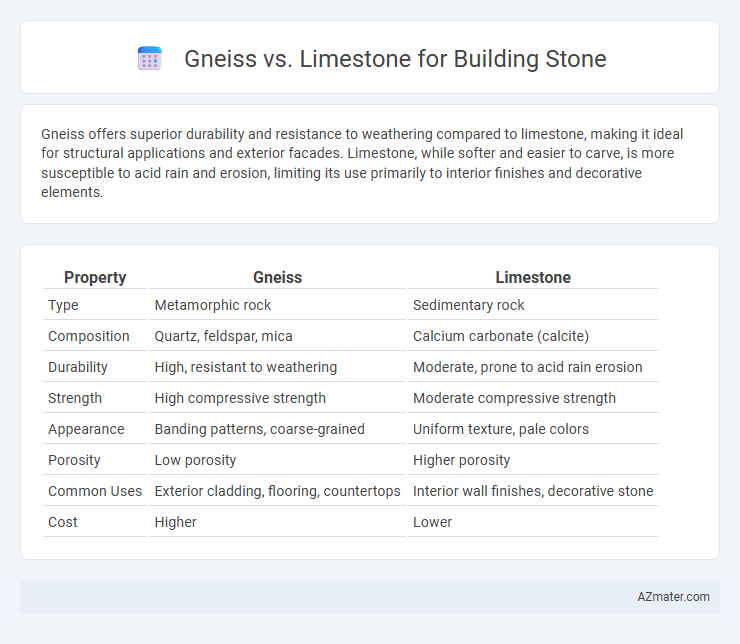Gneiss offers superior durability and resistance to weathering compared to limestone, making it ideal for structural applications and exterior facades. Limestone, while softer and easier to carve, is more susceptible to acid rain and erosion, limiting its use primarily to interior finishes and decorative elements.
Table of Comparison
| Property | Gneiss | Limestone |
|---|---|---|
| Type | Metamorphic rock | Sedimentary rock |
| Composition | Quartz, feldspar, mica | Calcium carbonate (calcite) |
| Durability | High, resistant to weathering | Moderate, prone to acid rain erosion |
| Strength | High compressive strength | Moderate compressive strength |
| Appearance | Banding patterns, coarse-grained | Uniform texture, pale colors |
| Porosity | Low porosity | Higher porosity |
| Common Uses | Exterior cladding, flooring, countertops | Interior wall finishes, decorative stone |
| Cost | Higher | Lower |
Introduction to Gneiss and Limestone
Gneiss is a high-grade metamorphic rock characterized by its distinct banding and foliation, formed under intense heat and pressure from pre-existing rocks such as granite or sedimentary rocks. Limestone is a sedimentary rock primarily composed of calcium carbonate, often formed from marine organisms' skeletal fragments, and widely used for its durability and workability in construction. Both stones offer unique aesthetic and structural properties, with gneiss providing a hard, resistant surface and limestone valued for its ease of shaping and historical significance in architecture.
Geological Formation and Characteristics
Gneiss, a metamorphic rock formed under high temperature and pressure, exhibits a banded texture and high durability, making it ideal for structural applications. Limestone, a sedimentary rock primarily composed of calcite from marine organisms, features a fine-grained texture and is more susceptible to chemical weathering. The geological formation of gneiss results in greater strength and resistance, while limestone's depositional origin leads to varied porosity and softness, influencing their suitability as building stones.
Physical Properties and Appearance
Gneiss exhibits a coarse-grained texture with distinct banding caused by mineral segregation, offering high durability and resistance to weathering, making it ideal for structural applications. Limestone features a finer, more uniform grain with a smooth surface and typically displays soft beige to gray hues, valued for ease of cutting and aesthetic versatility in architectural finishes. Physically, gneiss has greater compressive strength and hardness compared to limestone, which is more porous and susceptible to acid rain erosion.
Durability and Weather Resistance
Gneiss exhibits superior durability and weather resistance compared to limestone due to its high density and crystalline structure, making it ideal for exterior building applications. Limestone, being more porous and softer, is prone to erosion and chemical weathering, especially in acidic or humid environments. Gneiss's resistance to freeze-thaw cycles and abrasion ensures longer-lasting structural integrity in harsh weather conditions.
Workability and Ease of Shaping
Gneiss offers superior workability and ease of shaping compared to limestone due to its foliated texture, which allows for easier splitting along mineral layers, making it ideal for detailed architectural elements. Limestone, though softer and easier to carve initially, tends to crumble or wear down faster under mechanical stress, limiting its use in structures requiring long-term durability. The interlocking crystalline structure of gneiss provides greater resistance to abrasion and deformation, enhancing its suitability for heavy-duty building applications.
Structural Strength and Load-Bearing Capacity
Gneiss exhibits high structural strength and exceptional load-bearing capacity due to its foliated, interlocking mineral grains, making it ideal for heavy foundation and structural applications. Limestone, while moderately strong and easier to work with, offers lower load-bearing capacity and is more susceptible to weathering and acid rain, which can compromise long-term durability. Engineers often prefer gneiss for critical load-bearing elements where strength and resistance to deformation are paramount.
Aesthetic Appeal and Design Versatility
Gneiss offers a unique, banded texture with natural speckles and varying shades of gray, pink, and white that enhance architectural aesthetics through its elegant, earthy patterns. Limestone provides a smooth, uniform surface with soft beige, cream, or gray tones, ideal for classic and minimalist designs emphasizing subtlety and warmth. Both stones deliver design versatility; gneiss suits rustic or contemporary styles, while limestone adapts well to formal, traditional, and Mediterranean-inspired constructions.
Cost Comparison and Availability
Gneiss and limestone differ significantly in cost and availability as building stones, with limestone generally being more affordable due to its widespread global deposits and easier quarrying processes. Gneiss, a metamorphic rock with higher density and durability, tends to be pricier, reflecting its limited supply in specific geological regions and increased extraction complexity. Availability of limestone in sedimentary basins ensures consistent access for large construction projects, while gneiss's presence in mountainous zones can restrict supply and elevate transportation costs.
Environmental Impact and Sustainability
Gneiss offers superior durability and resistance to weathering, reducing the need for frequent replacements and thus lowering the long-term environmental footprint compared to limestone, which is more prone to erosion and acid rain damage. Limestone quarrying releases significant amounts of CO2 due to calcination during processing, whereas gneiss extraction typically involves less energy-intensive methods, contributing to better sustainability. Recycling gneiss waste in construction and landscaping further minimizes environmental impact, whereas limestone waste disposal can result in soil and water acidification.
Best Applications for Gneiss and Limestone in Construction
Gneiss is ideal for structural applications such as foundation walls, paving stones, and decorative facades due to its high durability, strength, and resistance to weathering. Limestone is commonly used for interior flooring, cladding, and ornamental details because of its workability, aesthetic appeal, and ability to be polished smoothly. Both stones offer unique benefits, with gneiss excelling in load-bearing and exterior uses while limestone is preferred for detailed architectural elements and indoor finishes.

Infographic: Gneiss vs Limestone for Building Stone
 azmater.com
azmater.com